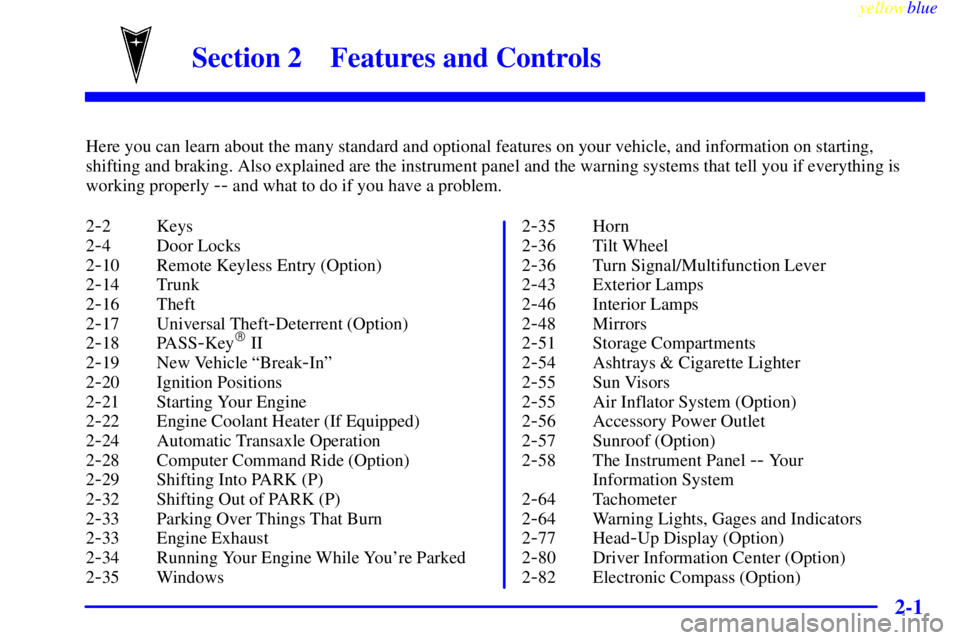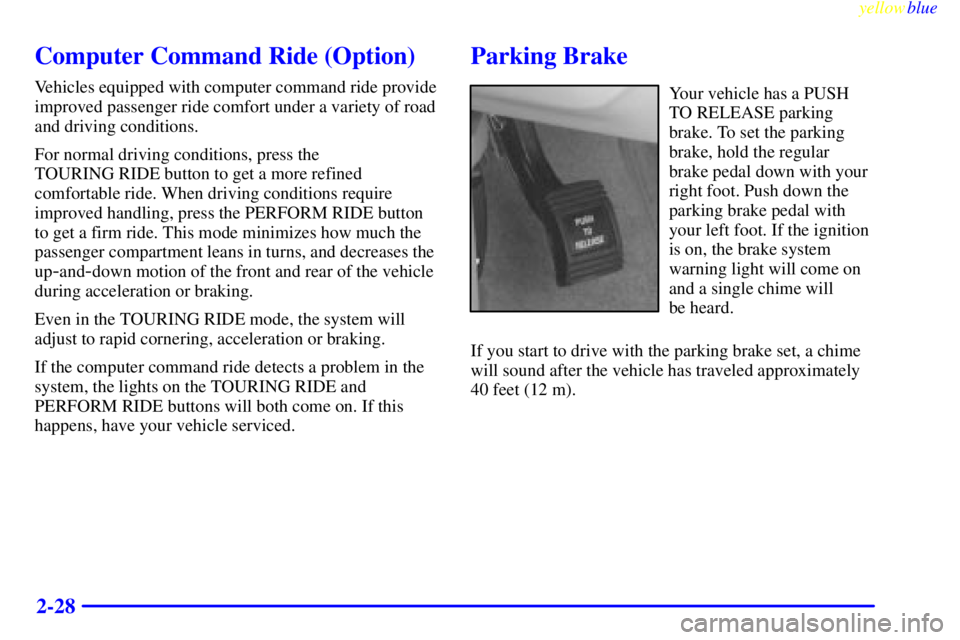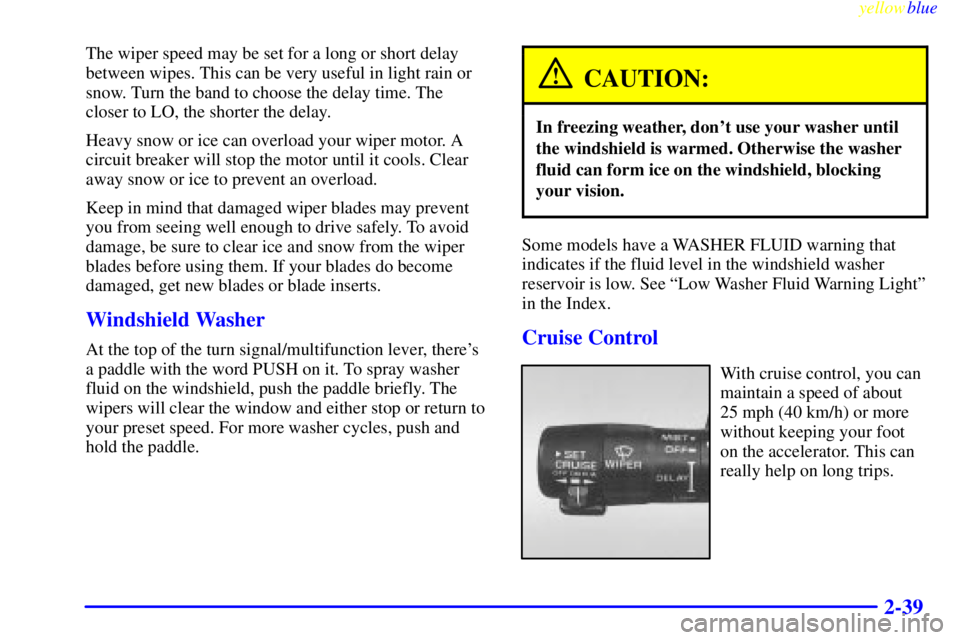Page 3 of 392

First Edition for Pontiac Bonneville Owner's Manual ± 1999
yellowblue
iii
How to Use this Manual
Many people read their owner's manual from beginning
to end when they first receive their new vehicle. If you
do this, it will help you learn about the features and
controls for your vehicle. In this manual, you'll find
that pictures and words work together to explain
things quickly.
Index
A good place to look for what you need is the Index in
back of the manual. It's an alphabetical list of what's in
the manual, and the page number where you'll find it.
Safety Warnings and Symbols
You will find a number of safety cautions in this book.
We use a box and the word CAUTION to tell you
about things that could hurt you if you were to ignore
the warning.
CAUTION:
These mean there is something that could hurt
you or other people.
In the caution area, we tell you what the hazard is. Then
we tell you what to do to help avoid or reduce the
hazard. Please read these cautions. If you don't, you or
others could be hurt.
You will also find a circle
with a slash through it in
this book. This safety
symbol means ªDon't,º
ªDon't do thisº or ªDon't
let this happen.º
Page 4 of 392
First Edition for Pontiac Bonneville Owner's Manual ± 1999
yellowblue
iv
Vehicle Damage Warnings
Also, in this book you will find these notices:
NOTICE:
These mean there is something that could
damage your vehicle.
In the notice area, we tell you about something that can
damage your vehicle. Many times, this damage would
not be covered by your warranty, and it could be costly.
But the notice will tell you what to do to help avoid
the damage.
When you read other manuals, you might see CAUTION
and NOTICE warnings in different colors or in
different words.
You'll also see warning labels on your vehicle. They use
the same words, CAUTION or NOTICE.
Page 5 of 392

First Edition for Pontiac Bonneville Owner's Manual ± 1999
yellowblue
v
For example,
these symbols
are used on an
original battery:
CAUTION
POSSIBLE
INJURY
PROTECT
EYES BY
SHIELDING
CAUSTIC
BATTERY
ACID COULD
CAUSE
BURNS
AVOID
SPARKS OR
FLAMES
SPARK OR
FLAME
COULD
EXPLODE
BATTERY
These symbols
are important
for you and
your passengers
whenever your
vehicle is
driven:
DOOR LOCK
UNLOCK
FASTEN
SEAT
BELTS
POWER
WINDOW
AIR BAG
These symbols
have to do with
your lamps:
MASTER
LIGHTING
SWITCH
TURN
SIGNALS
PARKING
LAMPS
HAZARD
WARNING
FLASHER
DAYTIME
RUNNING
LAMPS
FOG LAMPS
These symbols
are on some of
your controls:
WINDSHIELD
WIPER
WINDSHIELD
WASHER
WINDSHIELD
DEFROSTER
REAR
WINDOW
DEFOGGER
VENTILATING
FAN
These symbols
are used on
warning and
indicator lights:
ENGINE
COOLANT
TEMP
BATTERY
CHARGING
SYSTEM
BRAKE
COOLANT
ENGINE OIL
PRESSURE
ANTI-LOCK
BRAKES
Here are some
other symbols
you may see:
FUSE
LIGHTER
HORN
SPEAKER
FUEL
Vehicle Symbols
These are some of the symbols you may find on your vehicle.
Page 61 of 392

2-
yellowblue
2-1
Section 2 Features and Controls
Here you can learn about the many standard and optional features on your vehicle, and information on starting,
shifting and braking. Also explained are the instrument panel and the warning systems that tell you if everything is
working properly
-- and what to do if you have a problem.
2
-2 Keys
2
-4 Door Locks
2
-10 Remote Keyless Entry (Option)
2
-14 Trunk
2
-16 Theft
2
-17 Universal Theft-Deterrent (Option)
2
-18 PASS-Key� II
2
-19 New Vehicle ªBreak-Inº
2
-20 Ignition Positions
2
-21 Starting Your Engine
2
-22 Engine Coolant Heater (If Equipped)
2
-24 Automatic Transaxle Operation
2
-28 Computer Command Ride (Option)
2
-29 Shifting Into PARK (P)
2
-32 Shifting Out of PARK (P)
2
-33 Parking Over Things That Burn
2
-33 Engine Exhaust
2
-34 Running Your Engine While You're Parked
2
-35 Windows2
-35 Horn
2
-36 Tilt Wheel
2
-36 Turn Signal/Multifunction Lever
2
-43 Exterior Lamps
2
-46 Interior Lamps
2
-48 Mirrors
2
-51 Storage Compartments
2
-54 Ashtrays & Cigarette Lighter
2
-55 Sun Visors
2
-55 Air Inflator System (Option)
2
-56 Accessory Power Outlet
2
-57 Sunroof (Option)
2
-58 The Instrument Panel -- Your
Information System
2
-64 Tachometer
2
-64 Warning Lights, Gages and Indicators
2
-77 Head-Up Display (Option)
2
-80 Driver Information Center (Option)
2
-82 Electronic Compass (Option)
Page 80 of 392
yellowblue
2-20
Ignition Positions
Leaving children in a vehicle with the ignition key is
dangerous for many reasons. A child or others could be
injured or even killed. They could operate power
windows or other controls or even make the vehicle
move. Don't leave the keys in the vehicle with children.
With the ignition key in the ignition switch, you can turn
the switch to five positions.NOTICE:
If your key seems stuck in LOCK and you can't
turn it, be sure you are using the correct key; if
so, is it all the way in? If it is, then turn the
steering wheel left and right while you turn the
key hard. But turn the key only with your hand.
Using a tool to force it could break the key or the
ignition switch. If none of this works, then your
vehicle needs service.
Key Reminder Warning
If you leave your key in the ignition, in the OFF
position, you will hear a warning tone when you open
the driver's door.
Page 88 of 392

yellowblue
2-28
Computer Command Ride (Option)
Vehicles equipped with computer command ride provide
improved passenger ride comfort under a variety of road
and driving conditions.
For normal driving conditions, press the
TOURING RIDE button to get a more refined
comfortable ride. When driving conditions require
improved handling, press the PERFORM RIDE button
to get a firm ride. This mode minimizes how much the
passenger compartment leans in turns, and decreases the
up
-and-down motion of the front and rear of the vehicle
during acceleration or braking.
Even in the TOURING RIDE mode, the system will
adjust to rapid cornering, acceleration or braking.
If the computer command ride detects a problem in the
system, the lights on the TOURING RIDE and
PERFORM RIDE buttons will both come on. If this
happens, have your vehicle serviced.
Parking Brake
Your vehicle has a PUSH
TO RELEASE parking
brake. To set the parking
brake, hold the regular
brake pedal down with your
right foot. Push down the
parking brake pedal with
your left foot. If the ignition
is on, the brake system
warning light will come on
and a single chime will
be heard.
If you start to drive with the parking brake set, a chime
will sound after the vehicle has traveled approximately
40 feet (12 m).
Page 99 of 392

yellowblue
2-39
The wiper speed may be set for a long or short delay
between wipes. This can be very useful in light rain or
snow. Turn the band to choose the delay time. The
closer to LO, the shorter the delay.
Heavy snow or ice can overload your wiper motor. A
circuit breaker will stop the motor until it cools. Clear
away snow or ice to prevent an overload.
Keep in mind that damaged wiper blades may prevent
you from seeing well enough to drive safely. To avoid
damage, be sure to clear ice and snow from the wiper
blades before using them. If your blades do become
damaged, get new blades or blade inserts.
Windshield Washer
At the top of the turn signal/multifunction lever, there's
a paddle with the word PUSH on it. To spray washer
fluid on the windshield, push the paddle briefly. The
wipers will clear the window and either stop or return to
your preset speed. For more washer cycles, push and
hold the paddle.
CAUTION:
In freezing weather, don't use your washer until
the windshield is warmed. Otherwise the washer
fluid can form ice on the windshield, blocking
your vision.
Some models have a WASHER FLUID warning that
indicates if the fluid level in the windshield washer
reservoir is low. See ªLow Washer Fluid Warning Lightº
in the Index.
Cruise Control
With cruise control, you can
maintain a speed of about
25 mph (40 km/h) or more
without keeping your foot
on the accelerator. This can
really help on long trips.
Page 103 of 392

yellowblue
2-43 Lamps On Reminder
If you open the driver's door while leaving the
headlamps or parking lamps on and the key is removed
from the ignition, you will hear a warning chime.
Daytime Running Lamps
Daytime Running Lamps (DRL) can make it easier for
others to see the front of your vehicle during the day.
DRL can be helpful in many different driving
conditions, but they can be especially helpful in the
short periods after dawn and before sunset.
A light sensor on top of the instrument panel monitors
the exterior light level for the operation of DRL and
twilight sentinel, so be sure it isn't covered. The DRL
system will make your low
-beam headlamps come on at
a reduced brightness when:
�The ignition is on,
�The headlamp switch is off and
�The transaxle is not in PARK (P).When the DRL are on, only your low
-beam headlamps
will be on. The taillamps, sidemarker and other lamps
won't be on. Your instrument panel won't be
lighted either.
When it's dark enough outside, your low
-beam
headlamps will change to full brightness. The other
lamps that come on with your headlamps will also come
on. When it's bright enough outside, the regular lamps
will go off, and your low
-beam headlamps change to the
reduced brightness of DRL.
To idle your vehicle with the DRL off, shift the
transaxle into PARK (P). The DRL will stay off until
you shift out of PARK (P).